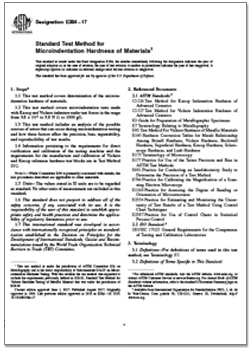英文名称:
ASTM A1038-17
Standard Test Method for Portable Hardness Testing by the Ultrasonic Contact Impedance Method
中文名称:
ASTM A1038-17
采用超声波接触阻抗法进行便携式硬度测试的标准试验方法
标准状态:已作废,被ASTM A1038-19替代
代号说明:
This standard is issued under the fixed designation A1038; the number immediately following the designation indicates the year of original adoption or, in the case of revision, the year of last revision. A number in parentheses indicates the year of last reapproval. A superscript epsilon (ε) indicates an editorial change since the last revision or reapproval.
版本说明:
1 This test method is under the jurisdiction of ASTM Committee A01 on Steel, Stainless Steel and Related Alloys and is the direct responsibility of Subcommittee A01.06 on Steel Forgings and Billets.
Current edition approved Nov. 1, 2017. Published December 2017. Originally approved in 2005. Last previous edition approved in 2013 as A1038 – 13 ɛ1 . DOI: 10.1520/A1038-17.
2 For referenced ASTM standards, visit the ASTM website, www.astm.org, or contact ASTM Customer Service at service@astm.org. For Annual Book of ASTM Standards volume information, refer to the standard’s Document Summary page on the ASTM website.
标准正文:
1. Scope
1.1 This test method covers the determination of comparative hardness values by applying the Ultrasonic Contact Impedance Method (UCI Method).
1.2 The values stated in SI units are to be regarded as standard. No other units of measurement are included in this standard.
1.3 This standard does not purport to address all of the safety concerns, if any, associated with its use. It is the responsibility of the user of this standard to establish appropriate safety, health, and environmental practices and determine the applicability of regulatory limitations prior to use.
1.4 This international standard was developed in accordance with internationally recognized principles on standardization established in the Decision on Principles for the
Development of International Standards, Guides and Recommendations issued by the World Trade Organization Technical Barriers to Trade (TBT) Committee.
2. Referenced Documents
2.1 ASTM Standards:
A370 Test Methods and Definitions for Mechanical Testing of Steel Products
E10 Test Method for Brinell Hardness of Metallic Materials
E18 Test Methods for Rockwell Hardness of Metallic Materials
E140 Hardness Conversion Tables for Metals Relationship Among Brinell Hardness, Vickers Hardness, Rockwell Hardness, Superficial Hardness, Knoop Hardness, Scleroscope Hardness, and Leeb Hardness
E177 Practice for Use of the Terms Precision and Bias in ASTM Test Methods
E384 Test Method for Microindentation Hardness of Materials
E691 Practice for Conducting an Interlaboratory Study to Determine the Precision of a Test Method
3. Terminology and Equations
3.1 Definitions:
3.1.1 calibration—determination of the specific values of the significant operating parameters of the UCI instrument by comparison with values indicated by a standardized workbench hardness tester or by a set of certified reference test pieces.
3.1.2 surface finish—all references to surface finish in this test method are defined as surface roughness (that is, Ra = average roughness value).
3.1.3 UCI hardness test—a hardness testing method using a calibrated instrument by pressing a resonating rod with a defined indenter, for example, a Vickers diamond, with a fixed force against the surface of the part to be tested.
3.1.4 UCI method—Ultrasonic Contact Impedance, a hardness testing method developed by Dr. Claus Kleesattel in 1961 based on the measurement of the frequency shift of a resonating rod caused by the essentially elastic nature of the finite area of contact between the indenter and the test piece during the penetration.
3.1.5 verification—checking or testing the UCI instrument to ensure conformance with this test method.
3.2 Equations:
3.2.1 The average x of a set of n measurements is calculated as:
where each of the individual measurements is the result from a single indentation.
3.2.2 The error E in the performance of an ultrasonic contact impedance hardness testing instrument at each hardness level, relative to a standardized reference value, is
calculated as an absolute percent error determined as:
where:


在线阅读 免费下载









